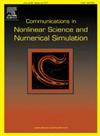Modelling wildfire propagation using the stochastic level-set method
IF 3.8
2区 数学
Q1 MATHEMATICS, APPLIED
Communications in Nonlinear Science and Numerical Simulation
Pub Date : 2025-09-19
DOI:10.1016/j.cnsns.2025.109305
引用次数: 0
Abstract
The modelling of wildfire spread involves managing uncertainties from various sources, typically addressed through probabilistic rather than deterministic approaches. Natural random variability in the dynamics of the fire front can be directly captured by integrating stochastic noise into the fire front tracking model. To achieve this, a Gaussian noise is introduced into the level-set model using a stochastic level-set approach in the wildfire spread simulator “spark”. The incorporation of stochasticity into the fire spread model enables the simulation to capture variability in fire front growth.
The model is calibrated and validated by comparing the stochastic fire spread simulations to observed fire data. The developed model is also compared to a specific case of fire spread simulation created using the Wildland-Urban Fire Dynamic Simulator (wfds). This comparative analysis provides a conclusive evaluation, highlighting the performance and capabilities of the stochastic approach in capturing the uncertainties and complexities of fire behavior.
用随机水平集方法模拟野火传播
野火蔓延的建模涉及管理来自各种来源的不确定性,通常通过概率方法而不是确定性方法来解决。通过将随机噪声集成到火锋跟踪模型中,可以直接捕获火锋动力学中的自然随机变异性。为了实现这一点,在野火蔓延模拟器“spark”中使用随机水平集方法将高斯噪声引入水平集模型。将随机性纳入火灾蔓延模型使模拟能够捕捉火锋增长的可变性。通过将随机火灾蔓延模拟与实际火灾数据进行比较,对模型进行了标定和验证。开发的模型还与使用荒地-城市火灾动态模拟器(wfds)创建的火灾蔓延模拟的具体案例进行了比较。这种比较分析提供了一个结论性的评估,突出了随机方法在捕捉火灾行为的不确定性和复杂性方面的性能和能力。
本文章由计算机程序翻译,如有差异,请以英文原文为准。
求助全文
约1分钟内获得全文
求助全文
来源期刊

Communications in Nonlinear Science and Numerical Simulation
MATHEMATICS, APPLIED-MATHEMATICS, INTERDISCIPLINARY APPLICATIONS
CiteScore
6.80
自引率
7.70%
发文量
378
审稿时长
78 days
期刊介绍:
The journal publishes original research findings on experimental observation, mathematical modeling, theoretical analysis and numerical simulation, for more accurate description, better prediction or novel application, of nonlinear phenomena in science and engineering. It offers a venue for researchers to make rapid exchange of ideas and techniques in nonlinear science and complexity.
The submission of manuscripts with cross-disciplinary approaches in nonlinear science and complexity is particularly encouraged.
Topics of interest:
Nonlinear differential or delay equations, Lie group analysis and asymptotic methods, Discontinuous systems, Fractals, Fractional calculus and dynamics, Nonlinear effects in quantum mechanics, Nonlinear stochastic processes, Experimental nonlinear science, Time-series and signal analysis, Computational methods and simulations in nonlinear science and engineering, Control of dynamical systems, Synchronization, Lyapunov analysis, High-dimensional chaos and turbulence, Chaos in Hamiltonian systems, Integrable systems and solitons, Collective behavior in many-body systems, Biological physics and networks, Nonlinear mechanical systems, Complex systems and complexity.
No length limitation for contributions is set, but only concisely written manuscripts are published. Brief papers are published on the basis of Rapid Communications. Discussions of previously published papers are welcome.
 求助内容:
求助内容: 应助结果提醒方式:
应助结果提醒方式:


